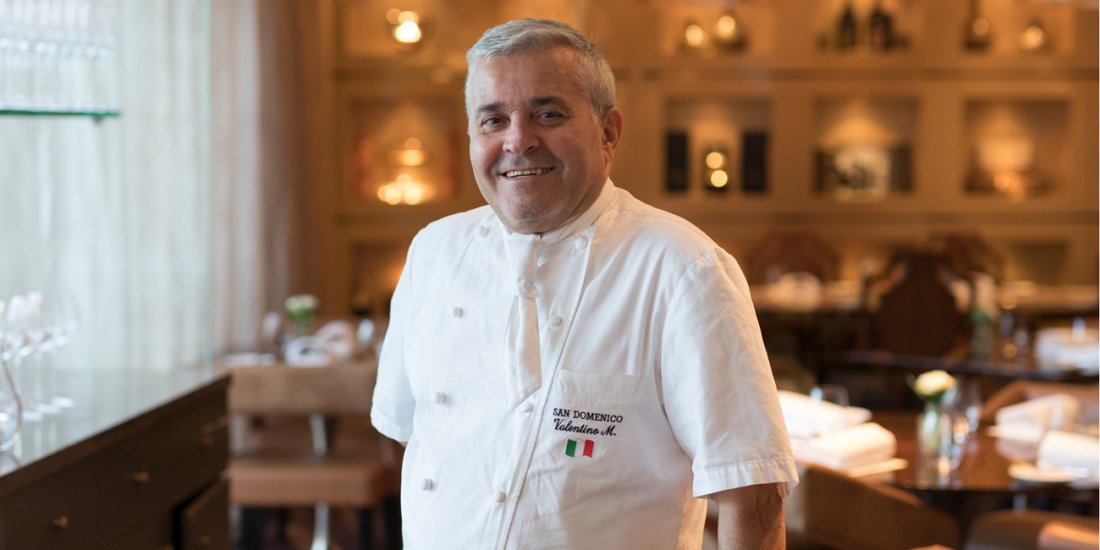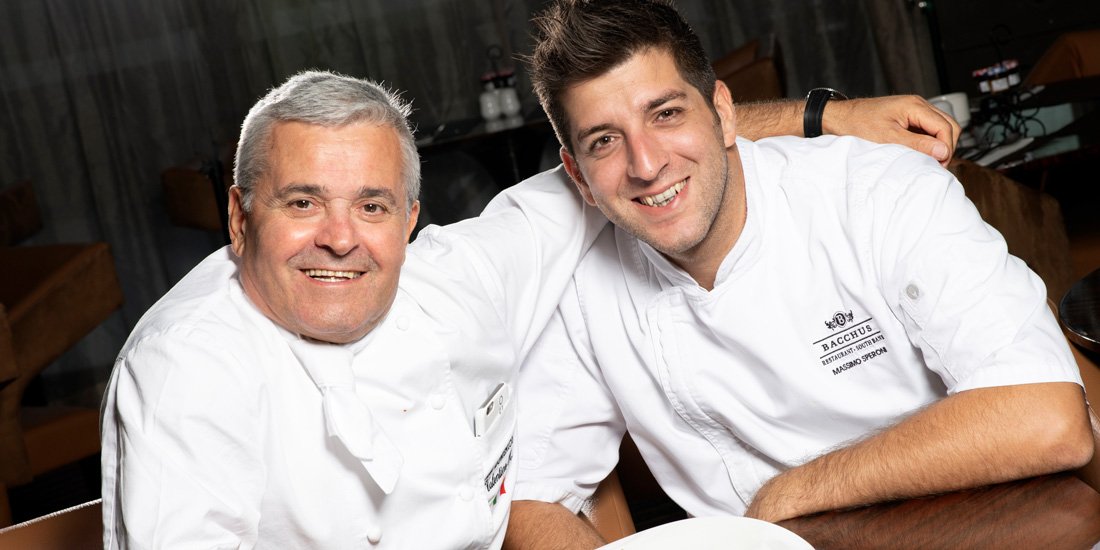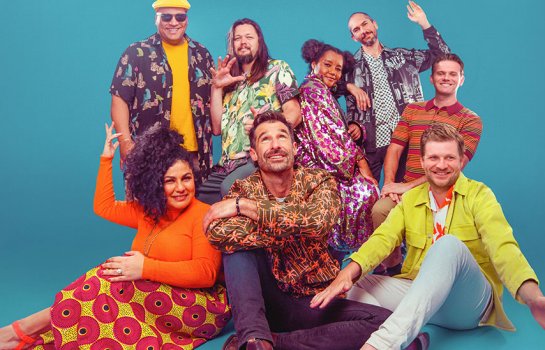Valentino Marcattilii, chef, Restaurant San Domenico
To stay at the same level until now, you need to treat every guest as the same. The quality of the food needs to be the same, the produce needs to be the best available and the staff need to be trained properly ...
Although the Michelin Guide doesn’t extend as far as our shores, most Australian foodies are aware of the guide’s reputation. A Michelin Star is one of the biggest indicators of culinary excellence around the world, pinpointing the best places to eat year in and year out. Earning one Michelin Star is no mean feat, let alone two. Holding two stars for 40 years is nearly unheard of, which is why chef Valentino Marcattilii is a big deal in his home country of Italy. As co-owner and chef of Restaurant San Domenico in Imola, Valentino has been maintaining a standard of excellence since first entering the kitchen at the age of 17. Now, the heralded chef is bringing his talents to Brisbane, teaming up with former San Domenico sous chef Massimo Speroni at Bacchus. The dynamic duo will be delivering culinary excellence across a series of degustation dinners from September 18–22, but before Valentino mans the pans, we caught up to talk about his career beginnings and what to expect from his visit to Brisbane.
First of all, welcome to Brisbane! You’ve come at the best time of year.
Thanks very much. The weather is perfect – it’s like Italy at Easter time!
Growing up in Italy, I imagine that food was a huge part of your childhood. When did your love for food truly begin?
In each family in Italy, there’s always cooking. Traditionally the lady of the house didn’t work – she just looked after the kids and cooked. My mother cooked all the time for all the kids, three times a day. My family is from Abruzzi and my mother helped organise small banquets for weddings in the town. Because a lot of people didn’t have much money, all the cooks would prepare wedding dinners and lunches as a hobby, so I was always around food.
Before earning acclaim at Restaurant San Domenico, how did you first come to work in the restaurant?
In the 1960s my family moved to Imola, where San Domenico is. I didn’t like school much, so I went to work when I could. San Domenico had only recently opened and my brother was one of the waiters. When I finished school I worked making coffee and delivering by bicycle – coffee deliveries around town! After a year my brother told me that the chef needed help in the kitchen, so I went to work and started there.
So your career at Restaurant San Domenico started early! What was working in the restaurant like at the beginning?
The current chef of San Domenico was a normal chef making simple and regional food. When the restaurant opened it had three partners and the chef was one of them, but one day the owners split and only one remained. I had worked with the chef there for three years before he left, but when they separated my experience was still very minimal – so they needed a new chef! There was only me, a lady that prepared pasta and the dishwasher. At this point the owner started to look for someone a bit more experienced but the biggest chefs at the time were all working for rich families. They wanted someone to come to San Domenico to teach and cook. They found one chef – Nino Bergese – who had recently retired. They weren’t sure if he would agree to come and work at San Domenico – he was the last chef of the last king of Italy, but he was living in Genoa so he didn’t want to move. However, he changed his mind and came to look at the restaurant and talk to me – I was only 17 at the time. He agreed to come for ten days to teach me and would get paid by the recipe, but he ended up staying for six years. Many people that knew his work would come to eat and Mr Bergese came back to life! He was 70 years old, but the work rejuvenated him.
During this period under Nino’s tutelage, what were some of the most important lessons that you learned?
I was young and I had so many girlfriends at the time. (laughs) But with Bergese I stayed in the kitchen all the time. I had to learn to make many things. Bergese’s food was not the regular food for the Italian people, it was food for rich people – very particular dishes, rich, used special produce. I had to make the sponge cake by hand all afternoon – I had to whip it by hand. Every afternoon and after every service I stayed to learn something different. Bergese and I had become close and we were friends as well, which was good because I had no more social life. (laughs) He taught me to love the work, so it didn’t feel like a job.
Although Nino Bergese’s fare was quite particular and refined, yours has been described as home-style fare. How did you hone your own style of cooking after learning the trade from Nino?
It was very important for me that I get more experience. I had worked with Nino Bergese for six years, so that was six years learning from only one chef, preparing one kind of food at one restaurant. I left Imola and moved to France to work at restaurants like La Pyramide, Madame Point and Auberge de l’Ile and Vergé – some of the best restaurants in France at the time. When I went back to Imola I mixed the very organised style of French cuisine I learned with the recipes and tastes of Bergese. It was a marriage between French professionalism and the rustic style of Italy.
After taking over San Domenico and earning the first Michelin star in 1976, how did you keep the standard so high over the ensuing decades while keeping it exciting for you?
Nino Bergese didn’t really care about Michelin stars or anything, because he thought you had to pay for it! He was contacted by them but never replied or bothered so it was never a focus. To stay at the same level until now, you need to treat every guest as the same. The quality of the food needs to be the same, the produce needs to be the best available and the staff need to be trained properly. You need to have the kitchen and the dining room united, and having family around helps, too. With all of this in place you can repeat it every day and maintain the quality – the food and the preparation. It’s never been hard for us to keep that level – it’s natural.
On that note of training your staff, you’re here working with your former sous chef Massimo Speroni – head chef at Bacchus – for a series of degustation dinners. Are you excited to be working with Massimo again?
Absolutely, yes! When Massimo told me he wanted to organise something in Australia, I said yes straight away.
Can you tell us a bit about the menu that you collaborated with Massimo on?
Yes, we discussed it over Skype – every afternoon for me and night for him (laughs). We talked over Messenger, mail and by phone to organise the menu and the product. He prepared some dishes and sent me photos – he worked with me for six years so he knows everything! There are some dishes from Bacchus, like the Scotch fillet and Moreton Bay bugs that are Australian influences, and some from San Domenico.
How do you think your style of cooking has evolved over the past 40 years?
I’ve always kept the same home style, but I respect technology and new techniques. The new machines in kitchens these days are fantastic. When I started there were no blenders! The sponge cake that I whipped by hand in 20 minutes now can be whipped together in five minutes! It’s incredible! (laughs)
There are only a few tickets remaining to the final degustation dinner at Bacchus on Saturday September 22. Be quick or miss out on this memorable opportunity!



